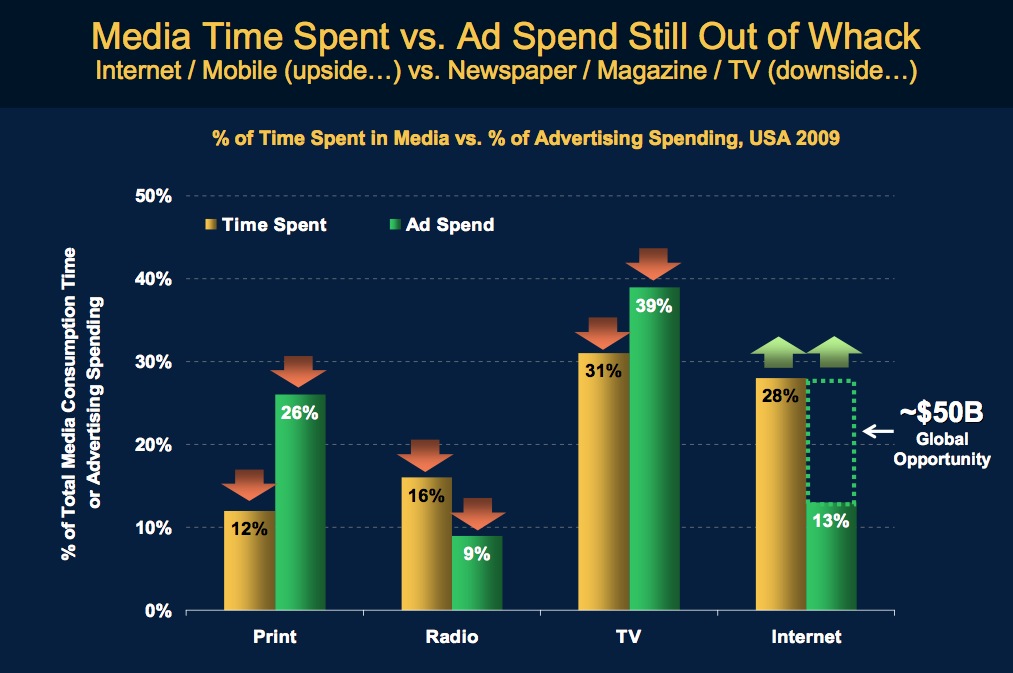9 Futurists Give 2020 Digital World Predictions to Mashable
July 11, 2012

9 Futurists give Mashable's Amy-Mae Elliott predictions for the digital future. Image courtesy of S58y. Used under Creative Commons license, http://creativecommons.org/licenses/by/2.0/deed.en.
We’re always interested in predictions for the future and were excited to be asked by Mashable’s Amy-Mae Elliott for one of our own in her article “9 Bold Predictions for the Digital World of 2020.” Dr. John Vanston chimed in on how voice quality by 2020 will be so excellent that “Younger generations will hear something that theretofore only older generations remember: the sound of a pin dropping.”
A couple of the futurists’ comments in the Mashable article refer to the massive amounts of information that is increasingly available to everyone. According to Dave Evans, Cisco Chief Futurist, “We are amassing unprecedented amounts of data – a zettabyte alone this year. This data is social and public (Facebook, Twitter, YouTube, blogs, etc.). Billions of devices (25-50 billion by 2020) will contribute exponentially to this avalanche of data … By 2015, Cisco Visual Networking Index predicts 1 million video minutes will traverse the Internet every second.”
According to Brian David Johnson, Futurist, Intel, “the size of the meaningful computational power keeps getting smaller and smaller. So, as we approach 2020 the size of the intelligent gets closer to zero in size, nearly invisible.”
Those that can use these massive amounts of information most imaginatively will have a very real advantage in the coming years. A good way to winnow through the information is finding minitrends in your areas of interest within the larger emerging trends. We talk extensively about this on this site and in our MINITRENDS book. Also stay tuned for our formal announcement of MINITRENDS 2012: A Conference on Translating Emerging Trends Into Business Opportunities scheduled October 17-18 at the Omni Downtown in Austin.
We are also intrigued by futurist Mike Walsh comments about virtual avatars: “By 2020 retail virtual avatars – on screens and in holographic projection – will start to become popular.” Perhaps, these virtual avatars will be waiting on us in the not too distant future!
We talk about Virtual Worlds being a minitrends opportunity in MINITRENDS. For the free excerpt from the book, see “Expanding Involvement in Virtual Worlds.”
Cheers,
Carrie
“Nine Emerging Minitrends to Watch” by Dr. John H. Vanston, MINITRENDS Author & Chairman, TFI
December 28, 2010
 Happy holidays to Minitrends blog readers! We appreciate your interest in our Minitrends posts and activities. As we start the new year, there will be many opportunities for those who are alert enough to recognize emerging trends, perceptive enough to realize their importance, and clever enough to take advantage of them. Here I suggest nine Minitrends—emerging trends that will become significantly important within 2-5 years, but are not yet generally recognized—that are well worth examining for possible action by those ambitious individuals who seek to start new ventures or keep existing businesses innovative and competitive.
Happy holidays to Minitrends blog readers! We appreciate your interest in our Minitrends posts and activities. As we start the new year, there will be many opportunities for those who are alert enough to recognize emerging trends, perceptive enough to realize their importance, and clever enough to take advantage of them. Here I suggest nine Minitrends—emerging trends that will become significantly important within 2-5 years, but are not yet generally recognized—that are well worth examining for possible action by those ambitious individuals who seek to start new ventures or keep existing businesses innovative and competitive.
Unlike megatrends, Minitrends are of a scope and importance to offer attractive opportunities to individual entrepreneurs, decision-makers in small and mid-size businesses, innovative thinkers in large companies, and adventuresome investors. In my new book, MINITRENDS: How Innovators & Entrepreneurs & Discover & Profit From Business & Technology Trends, I categorize the nine Minitrends below to those most applicable to different-sized groups. (In the book, I also discuss the background, current trends, and business opportunities of each of these Minitrends in more depth.) I do the same categorization below, but in reality, all provide opportunities to perceptive individuals in all-sized businesses.
Minitrends Particularly Applicable to Individuals or Small Groups of Individuals:
1. Expanding Involvement in Virtual Worlds (Free Virtual Worlds book excerpt available):
Virtual worlds are computer-based platforms that allow participants to engage in a wide range of real-world type activities, e.g., buying and building virtual world property, furnishing virtual world homes and offices, producing and selling virtual world goods, traveling, taking part in virtual world social activities such as parties and fundraisers, and communicating with other participants. Increasingly, virtual worlds are being used for educational purposes, product advertisements, new product modeling and testing, identification of new markets, and uncovering unexpected problems with new marketing programs.
2. Support for People Working at Home:
Although an increasing number of people are now conducting all or part of their work at home, these people often find they miss interacting with others and miss the convenience of facilities, equipment, and administrative support. A number of solutions are emerging to better meet the needs and desires of people working at home, including small offices or meeting rooms that can be rented by the day or the hour; chat rooms where people can meet informally to discuss ideas; semiformal groups that meet regularly to establish person-to-person interactions; and temporary support staffs organized to provide administrative assistance as needed.
3. Expanding Capabilities of Advanced Websites:
Although the World Wide Web had proven to be extremely popular, many believed a more interactive platform that took advantage of the Web’s power to communicate would be desirable (Web 2.0). Programmers are now expanding the capabilities of the Web to substitute computer activities for human activities, particularly activities that are repetitive, burdensome, and uninteresting (Web 3.0). Many believe Web 3.0 will eventually lead to effective artificial intelligence that can interact with humans in natural language.
Minitrends Particularly Applicable to Small and Medium-Size Companies:
4. Increasing Interest in Privacy:
Recent advances in technology, together with an increasing willingness of many to make personal information more easily available are threatening traditional concepts of privacy in terms of messaging, personal profiles, and identity. Techniques for countering these invasions of privacy, such as personal caution, technology aids, and group action are now being developed.
5. New Approaches to Giving and Receiving Advice:
Individuals and organizations commonly seek expert advice when making important decisions. In providing such advice, large consulting firms with large, multidisciplinary staffs, well-structured processes and procedures, huge computer capabilities, and long-standing reputations have traditionally had a major advantage. However, the ever-increasing power and ubiquity of information gathering, processing, and communicating technologies, small and medium-size consulting groups are often able to give more focused, timely, and user-friendly advice than the larger firms.
6. Evolution of Meaningful Maturity:
The twin trends of increasing life spans and decreasing retirement ages have caused a steady increase in retirement years. Because of social, personal interest, and/or financial reasons, many older individuals are either staying in their jobs longer or returning to the workforce. Their ability to utilize their experience, skills, and dedication effectively will depend on their current capabilities, their desires, and open opportunities to those willing to assist them.
Minitrends Particularly Applicable to Large Companies:
7. Advances in Digital Manufacturing:
Advanced digital manufacturing (ADM) processes build complex, custom-made parts by the addition of successive layers of material rather than traditional machining processes that cut, bend, and machine a part from stock material. The processes allow quicker production of prototypes and small production runs at a much lower cost. Recent ADM advances, including improved yield rates, reduced time-to-market, increasing variety of materials, and advances in 3D modeling software, have made ADM processes increasingly attractive to many manufacturers.
8. Increasing Electricity Use in Manufacturing:
The characteristics of electric power, such as high power density, no heat transfer medium requirements, controlled energy distribution, reduced material waste, and less environmental impacts, provide a number of benefits to manufacturing processes. Its use, however, has been limited by its relatively high cost. A number of factors, including advances in control technologies, changing customer needs, global competition, and increasing concern about the environment, are driving an increasing growth in the use of electricity in industrial processes.
9. New Applications of Nanotechnology:
When many substances are reduced to nano-size (100 nanometers or less) they often exhibit very different physical, electrical, chemical, and optical properties from the same substance at macro-size. These new properties often provide very unique and useful characteristics to nano-materials that can be used in a wide range of practical applications, such as cancer treatment, very high strength materials, special electronic systems, and water purification. Improved production techniques, decreased costs, and growing experience and understanding are increasing the practical applications of nanotechnologies
Minitrend involvement can give you a way to separate yourself from your colleagues and contemporaries. It provides a means for materially improving your business situation, your financial standing, and your personal satisfaction. I hope the Minitrends listed above will assist you or inspire you to launch your own exciting, profitable Minitrend Adventure that allows you to utilize your imagination, your logic, your innovative nature, and your basic good sense in the coming year.
Copyright 2011. Please feel free to reprint this article in whole or part with due credit to: “by Dr. John H. Vanston, MINITRENDS Author and Chairman, Technology Futures, Inc.” Thanks!
Meeker’s Top Internet Trends: Online Advertising Undervalued
November 17, 2010

Mary Meeker runs the global technology research team as a managing director of investment giant, Morgan Stanley. When Meeker talks, the market listens, and she was saying plenty at the recent Web 2.0 summit in San Francisco.
On Tuesday, November 16, Meeker shared her picks for the top Internet trends, backed up with some of the most cleverly crafted stats I’ve ever seen. Among the revelations: Print publications occupy only 12% of the amount of time consumers spend with media, yet account for 26% of advertising spending. This does not bode well for the future of advertiser-supported print media.
On the other hand, Meeker’s stats show that the Internet takes up 28% of people’s time for media, yet draws only 13% of advertisers’ budgets. She says there’s $50 billion too little being spent in online advertising.
Mashable’s Ben Parr summarized Meeker’s misallocation thusly: Facebook is “the most under-monitized asset in online advertising.” According to Meeker’s stats, social networking is earning a mere 55 cents per thousand impressions (CPM) from advertisers. Compare this to CPM’s of about $2.70 for the majority of websites that accept display advertising. Also grossly undervalued, according to Meeker, are display ads embedded in email, which earn only 89 cents CPM.
Parr was modest enough not to mention that Mashable ranked as one of the Top 10 brands on Twitter, coming in at position number 10 — right behind the National Basketball Association (NBA) and just ahead of Martha Stewart.
Another slide in Meeker’s presentation compared the number of people who “like” brands on Facebook with the number of viewers for popular television programs — and the CPMs associated with those TV shows. Zynga’s Texas Hold’em Poker leads the likes on Facebook with 27.2 million, which is roughly equivalent to the number of American Idol viewers. Whereas display ads on Facebook cost a mere $0.55 per thousand impressions, American Idol charges $30. We profiled Zynga founder Mark Pincus here on the Minitrends blog last month, where he talked about the importance of good eating habits.
Some of the other trends mentioned in the book, MINITRENDS, which also caught Mary Meeker’s eye, include the growth of virtual worlds. Meeker favorably compared the Japanese social networking site, Tencent (637 million active users), with Facebook (620 million annual visitors). The difference? Tencent is a virtual world using avatars. The shocking stat that caught my attention: over $1.4 billion in virtual goods have been sold on Tencent! Those are real yen shelled out for virtual merchandise such as outfits for avatars.
Another shocking stat: Seven of the top 15 Internet companies by market capitalization in 2004 are not in the top 15 today. Punishment is swift for those who do not stay on the edge of innovation. Case in point: Nokia and RIM held 70% of the smartphone market as recently as 2008. Today, that market share has dropped to 52% while Google (Android) and Apple (iPhone) have gone from nothing to gobbling up 42% of the market.
Despite a Morgan Stanley copyright notice, Mary Meeker’s slideshow seems to be everywhere online. You can find it at Mashable and TechCrunch, along with some very cursory commentary.
STEVE O’KEEFE
News Editor, Minitrends Blog
Source: “The Unprecedented Rise of Apple iOS and Other Internet Trends,” Mashable, 11/16/10
Source: “Mary Meeker On Ten Questions Internet Execs Should Ask And Answer,” TechCrunch, 11/16/10
Image from Morgan Stanley, used under Fair Use: Commentary.
Virtual Nightmare: Meth Labs in Second Life
October 11, 2010
 Gary Stix, who covers neuroscience for Scientific American, recently reported on how one researcher is using the virtual world, Second Life, to better understand drug cravings.
Gary Stix, who covers neuroscience for Scientific American, recently reported on how one researcher is using the virtual world, Second Life, to better understand drug cravings.
Chris Culbertson, a neuroscientist at UCLA, designed a virtual environment on Second Life in hopes of generating a Pavlovian response from drug users craving a fix. According to Stix,
Culbertson created a virtual meth house, a place where addicts gather, and invited 17 meth users to U.C.L.A. to test it out. To determine their levels of craving, Culbertson had the addicts fill out questionnaires and measured their heart rates as they navigated via computer through the meth house on Second Life.
Can you imagine recruiting 17 meth addicts to visit your lab? Stix doesn’t say what happened when they were released, presumably with a little cash in their pockets for participating in the experiment. He does say that Second Life’s meth house is a private affair, and not accessible to the public.
If that is not entertaining enough for you, the ads on Scientific American will enhance your experience of the article. Next to the story on meth labs in Second Life, SciAm carries an ad for “Into the Lost Crystal Caves” with what look like giant stalactites of crack. It’s enough to drive a meth addict wild. The ad is a promotion for a National Geographic program that premieres this Sunday.
Culbertson is not the only researcher using virtual reality to treat drug addiction. Duke University professor Zach Rosenthal has developed a virtual reality game to guide drug users through tempting environments in order to help them learn how to deal with cravings. Rosenthal told Good Morning America:
What we’re trying to do is take people into a virtual crack-related neighborhood or crack-related setting and have them experience cravings, just like they would in the real world.
Culbertson’s research has shown that virtual environments are more effective in eliciting cravings than other signals, such as videos of people using drugs. You can read an interview with Culbertson about his work in virtual worlds at the Medicine Meets Virtual Reality 17 blog.
STEVE O’KEEFE
News Editor, Minitrends Blog
Source: “Craving a Cure: A Virtual Meth House Serves as Fodder for Addiction Studies,” Scientific American, 10/07/10
Source: “Virtual Reality Game Helps Drug Addicts Recover,” Good Morning America, 11/05/07
Source: “The Salon Interviews: The Use of Virtual Reality in Addiction Medicine,” Medicine Meets Virtual Reality 17, 01/07/09
Image from ad in Scientific American, used under Fair Use: Commentary.
Virtual World Entrepreneur of the Year 2010
October 4, 2010
Last week, SLentrepreneur Magazine began accepting entries for the 2010 SLentrepreneur of the Year Award, and this year the contest is open to anyone with a Second Life identity. According to publisher and editor, Avarie Parker:
For the first time, I have opened up SLENTRE.COM’s contest for the top Second Life entrepreneur to anyone with a Second Life avatar. The voting this year is not limited to a small list of nominees but voters can ‘write-in’ the name of ANY virtual entrepreneur they feel has had an impact on the Second Life community.
Second Life is the largest online community, dubbed “virtual words,” in an ever-growing universe of synthetic reality. With over 18 million registered users, Second Life is the brand leader. If you are just trying to get your head around Facebook, you might consider leaping past it and building a profile on Second Life instead, because that’s where Facebook and other social networks are headed.
Second Life is part game and part serious business — just like real life. You’re born into Second Life as an avatar (a cartoon you). From there, you must make friends, get directions, and find work if you plan to buy anything like clothes or a house. In Second Life, transactions are made in Linden Dollars, named after Linden Labs, creator of Second Life.
 One way of making money from Linden Dollars is to exchange them for real currency. There are complications with any currency swaps, and Second Life has already experienced some serious banking disruptions. But people make real money selling such things as avatars and access to simulated environments.
One way of making money from Linden Dollars is to exchange them for real currency. There are complications with any currency swaps, and Second Life has already experienced some serious banking disruptions. But people make real money selling such things as avatars and access to simulated environments.
People also make money using virtual worlds to do real-world activities, such as meetings, in a less expensive and more creative environment. Many companies make presentations and buy advertising in virtual worlds. Many other companies use virtual-world real estate for team projects.
One place to start investigating virtual worlds is Expanding Involvements in Virtual Worlds, an excerpt from the new book MINITRENDS, by John and Carrie Vanston. I also recommend SLentrepreneur Magazine and its website, SLentre.com, for their coverage of entrepreneurship in virtual worlds, including profiles of the nominees for SLentrepreneur of the Year in 2008 and 2009.
Second Life also provides an excellent summary, called Working in Second Life, that explains novel ways to use virtual worlds to save money or make money in the real world. I recommend the 10-page PDF version for a quick download on doing business in Second Life.
STEVE O’KEEFE
News Editor, Minitrends Blog
Source: “Vote for SLentrepreneur of the Year 2010,” SLentrepreneur Magazine, 09/30/10
Source: “Working In Second Life FAQs,” Linden Research, Inc.
Image Source: Second Life Logo, Linden Research, Inc.; used under Fair Use: Reporting.
Doctors Prescribe Virtual Reality for Returning Iraq Veterans
September 28, 2010
A video tour of Virtual Iraq, courtesy NewYorkerDotCom.
One of the MINITRENDS discussed in the book MINITRENDS is the “Expanding Involvement in Virtual Worlds.” We are giving away that excerpt from the book at the MINITRENDS website. One of the timely ways virtual worlds are being used is to treat Post-Traumatic Stress Disorder (PTSD) in returning Iraq War veterans.
In an article on the blog NextGov, a new project from GovernmentExecutive.com, Bob Brewin tells us that as many as 35% of Iraq War veterans suffer from PTSD. Brewin reveals:
[T]he Army has instigated a four-year study at the Madigan Army Medical Center in Tacoma [Washington] to track the results of using virtual reality to treat the disorder.
The specific therapy cited in Brewin’s article is the VR program, Virtual Iraq, developed by Dr. Michael Kramer at the Veterans’ Administration’s PTSD Clinic. Caitlin McNally at FRONTLINE interviewed Dr. Kramer about the technology in 2009.
Virtual Iraq is a simulated Iraq War environment designed to help vets relive traumatic events as a trigger to talking about them or releasing pent-up emotions. “It is not a game,” says The New Yorker‘s Sue Halprin in a video tour of Virtual Iraq.
In one of the ironic twists to this story, Virtual Iraq was made from a video game, “Full Spectrum Warrior,” that was itself made from a training video used by the Department of Defense. The game was transformed into an immersion-therapy virtual world by Albert Rizzo, a psychologist working with the Institute for Creative Technologies at the University of Southern California (USC).
In her detailed article for The New Yorker, Halprin collects anecdotal evidence of the effectiveness of virtual therapy from several vets and therapists trained to administer the VR program. Virtual therapy is an example of the business, medical, and scientific opportunities opening up for software and hardware that can immerse people into artificial worlds in a convincing way.
The U.S. Army is now using Virtual Iraq in six locations. If the early reports hold, we can expect to see a large increase in the number of facilities offering virtual therapy, and not just for PTSD.
by Steve O’Keefe
News Editor, Minitrends Blog
Source: “Army studying use of virtual reality to treat post-traumatic stress,” NextGov, 02/22/10
Source: “Virtual reality therapy in New York,” FRONTLINE, 04/23/09
Source: “Virtual Iraq,” The New Yorker, 05/19/08
Source: “Not a Game: Inside Virtual Iraq” (VIDEO), NewYorkerDotCom, 05/19/08


